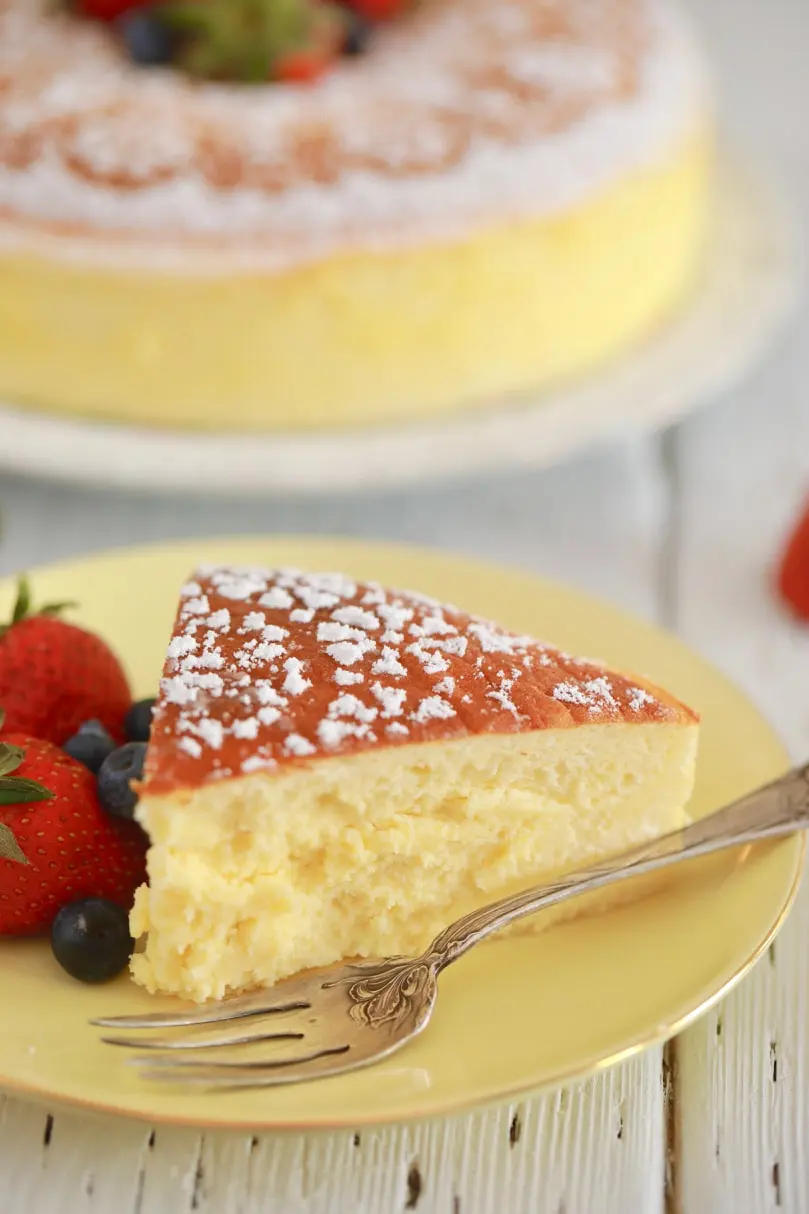Japanese Cheesecake – Learn to make a light and airy Japanese Cheesecake at home. This classic dessert is a mix of lightness and creaminess. It comes from combining egg yolk custard with whipped meringue for that special bounce.
Adding cream cheese, butter, and milk makes each bite rich and indulgent. With patience and care, you can make this Japanese treat perfectly. You’ll get the airy texture and rich taste everyone loves.
What is Japanese Cheesecake?
Japanese cheesecake, also known as “jiggly cake” or “soufflé cheesecake,” is a unique dessert. It has become popular all over the world. Unlike traditional baked cheesecake, it’s known for its airy, cotton-like texture and delicate, custard-like consistency.
The Difference Between Japanese Cheesecake and Regular Cheesecake
The main difference between Japanese cheesecake and regular cheesecake is the use of whipped egg whites. Classic cheesecake is dense and rich, but Japanese cheesecake is light and fluffy. This makes it less heavy than American-style cheesecake.
Japanese cheesecake is also less sweet and has a delicate flavor. It doesn’t have a crust and is baked in a water bath. These factors make it unique.
“Japanese souffle cheesecake is also known as Japanese cotton cheesecake or Japanese cheesecake.”
The Secret to Achieving the Perfect Jiggly Texture
The secret to the fluffy and jiggly texture of Japanese cheesecake is simple: meringue. Instead of using whole eggs, the recipe whips egg whites into a glossy meringue. Then, it gently folds this into the cheesecake batter. This adds lots of air and structure, making a tall and fluffy cheesecake that doesn’t need a crust or extra toppings.
The recipe uses low protein flour and starch mix for its unique texture. Keeping the right oven temperature is key for a great meringue cheesecake. Start at 150°C / 302°F and then drop it to 110°C / 230°F for the best results.
Using a water bath while baking is vital to avoid cracks and ensure even cooking. It’s important to use room temperature eggs and separate the yolks from the whites for the meringue. The batter is made by folding the egg whites into the egg yolk mixture gently, keeping it fluffy.
| Ingredient | Quantity |
|---|---|
| Cream Cheese | 450 grams |
| Eggs | 3 whole |
| Milk | 60 ml |
| All-purpose Flour | 30 grams |
| Corn Starch | 30 grams |
| Butter | 50 grams |
| Sugar | 60 grams |
The Japanese jiggly cheesecake should be creamy, airy, and melt-in-your-mouth soft. By using this recipe and method, you can make the perfect fluffy cheesecake with the famous jiggly texture. Your guests will be impressed.
“The secret to the fluffy and jiggly texture of Japanese cheesecake is plain old meringue.”
Ingredients
Explore the world of Japanese cheesecake with this simple recipe. It’s known for its light, jiggly, and fluffy texture. This cheesecake combines a creamy custard base with a meringue topping for a perfect balance of flavors and textures.
To start, you’ll need these ingredients:
- 4 large egg whites
- 4 large egg yolks
- 8 ounces (227g) of cream cheese
- 1/3 cup (66g) of granulated sugar for the meringue
- 3 tablespoons (37g) of granulated sugar for the cream cheese base
- 2/3 cup (151g) of heavy cream
- 1/2 cup (60g) of King Arthur Unbleached Cake Flour
- 2 tablespoons (43g) of apricot jam for the glaze
- 1 teaspoon of lemon juice for the glaze
Start by whipping the egg whites until they’re stiff and hold their shape. Add 1/3 cup (66g) of sugar while whisking until the meringue is stiff and shiny.
Next, mix the cream cheese, sugar, heavy cream, and egg yolks in another bowl. Whisk until it’s smooth. Then, sift in the cake flour and fold it into the mix until combined.
Now, gently mix the meringue with the cream cheese base. This adds air for the fluffy texture. Pour the mix into a parchment-lined pan and bake at 325°F for 50 to 60 minutes. The top should be golden brown.
Let the Japanese cheesecake cool in the fridge for about 2 hours before serving. For the glaze, mix apricot jam and lemon juice. Drizzle it over the cheesecake after it’s chilled.
Enjoy this homemade Japanese cheesecake for its light, airy, and creamy taste. The easy Japanese cheesecake recipe is perfect for impressing guests.
Tips and variations
Avoiding Cracks and Ensuring Success
Making a perfect Japanese cheesecake takes some skill, but you can get it right with the right methods. Focus on preparing the meringue well and baking the cake in a water bath. This ensures a soft, jiggly, and crack-free cheesecake every time.
Begin by making sure your egg whites are at room temperature and your mixing bowl is clean. This helps the meringue whip up to the perfect soft-medium peak stage. This is key for the cake’s light texture. Also, baking the cheesecake in a water bath keeps it moist and stops cracks from forming.
It’s important to watch the oven temperature and baking time closely. Preheat the oven to 392°F (200°C), then lower it to 284°F (140°C) for the rest of the baking. This two-step temperature helps the cake rise and get its signature jiggly texture. Let the cake cool slowly in the oven to prevent sudden temperature changes that could cause cracks.
By using these tips for tips for Japanese cheesecake, avoiding cracks in cheesecake, water bath for cheesecake, and oven temperature for cheesecake, you’ll be on your way to making perfect Japanese-style cheesecakes.
FAQ
What is the secret to the fluffy and jiggly texture of Japanese cheesecake?
The secret lies in using beaten egg whites. These are whipped into a glossy meringue and then folded into the batter. This adds lots of air and structure, making the cake tall and fluffy with a custard-like wobble.
How is Japanese cheesecake different from regular American-style cheesecake?
Japanese cheesecake doesn’t have a crust and is less dense. It’s also less sweet. The beaten egg whites make it light and airy, unlike the dense, rich texture of traditional cheesecake.
What are the essential steps to achieve the perfect Japanese cheesecake?
For a great Japanese cheesecake, follow these steps:
1. Prepare the egg whites and meringue well for airiness.
2. Bake it in a water bath to keep it moist and prevent cracks.
3. Watch the oven closely, start at high heat, then lower it, and cool the cake in the oven.
Can I add any additional ingredients or toppings to Japanese cheesecake?
Yes, you can add things like lemon juice, vanilla, or fresh berries. But, the classic version is often enjoyed plain. This lets the cheesecake’s fluffy texture and rich flavor shine.
How can I ensure my Japanese cheesecake doesn’t crack?
To avoid cracks, bake it in a water bath. This keeps the cake moist and evenly cooked. Also, monitor the oven temperature and time closely. Start high, then lower it, and cool the cake in the oven for a crack-free result.

